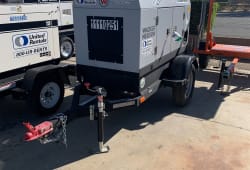How Does a Generator Work? The Power Behind the Machines
5 Min read
)
August 27, 2024
In a world that relies on continuous power, generators are the backbone that keeps everything running smoothly. Whether it's powering essential systems during an outage or delivering electricity to remote construction sites, generators play a critical role in ensuring we stay connected and productive. But what goes on inside these powerful machines?
How a Generator Produces Electricity
Starting the Engine
The operation of a generator begins with the engine, which runs on a specific fuel source, such as gasoline, diesel, natural gas, or propane. When the engine is started, it converts the energy stored in the fuel into mechanical energy by driving the crankshaft, similar to how a car engine operates.
Creating a Magnetic Field
This mechanical energy is then used to rotate the rotor, a component within the generator's alternator. The rotor is attached to a shaft that spins rapidly, creating a magnetic field around it. This rotating magnetic field is essential for generating electricity.
Inducing Electrical Current
As the rotor spins, it interacts with the stator, which is composed of stationary coils of wire surrounding the rotor. The moving magnetic field induces an electrical current in the stator's windings through electromagnetic induction. This induced current is the fundamental electricity that the generator produces.
Regulating the Voltage
The raw electrical current generated in the stator is often uneven and needs to be stabilized. A voltage regulator within the generator adjusts and maintains the electrical output to a consistent and safe voltage level. This ensures that the electricity is suitable for powering various devices and machinery without causing damage.
Distributing the Electricity
Once the voltage is regulated, the electricity is routed to the generator’s outlets or connection points. From there, it can be used to power anything from small appliances to large industrial equipment, or even entire buildings, depending on the generator's capacity. The electricity generated can be used directly or stored for later use, making generators a vital resource for backup power and remote energy needs.
Parts of a Generator
:format(webp)) Engine
Engine
The engine is the power source of the generator, converting fuel like gasoline, diesel, or natural gas into mechanical energy. This energy drives the generator’s alternator to produce electricity. The engine’s size and fuel type directly influence the generator’s overall power output and efficiency.
Alternator
The alternator converts mechanical energy from the engine into electrical energy. It contains a rotor that spins within a stator, creating a magnetic field that induces an electrical current. The design and materials of the alternator play a key role in determining the quality and consistency of the generated electricity.
Fuel System
The fuel system supplies the engine with the necessary fuel to keep it running. It includes components like a fuel tank, pump, and injectors. A well-designed fuel system ensures the generator operates efficiently and can run for extended periods without interruption.
Voltage Regulator
The voltage regulator ensures the electricity produced by the generator is stable and consistent. It adjusts the alternator’s output to match the required load, protecting connected devices from voltage fluctuations and ensuring reliable operation.
Cooling and Exhaust Systems
These systems manage the heat and exhaust gases produced during generator operation. The cooling system prevents the engine from overheating, while the exhaust system safely vents harmful gases like carbon monoxide. Proper cooling and exhaust are vital for the safe and efficient functioning of the generator.
Battery Charger
The battery charger keeps the generator’s battery charged, ensuring it’s always ready to start the engine, especially in standby generators. This component is crucial for maintaining readiness, even after long periods of inactivity.
Control Panel
The control panel is the interface through which the user interacts with the generator. It displays key information such as voltage and frequency and may include features like remote monitoring and automatic start/stop. The control panel enables effective management of the generator’s operation.
Types of Generators
Generators come in various types, each suited to different applications:
Portable Generators: Ideal for temporary power needs, such as at construction sites or during outdoor events.
Inverter Generators: Known for their efficiency and clean power output, they’re perfect for sensitive electronics and recreational use.
Standby Generators: Permanently installed, these generators automatically kick in during power outages, making them ideal for homes and businesses.
Industrial Generators: Built for heavy-duty applications, these generators are used in industrial settings where reliable, continuous power is critical.
The Role of Generators in Construction
In the construction industry, generators are indispensable. They provide power in remote locations where grid access is unavailable, keeping tools, lights, and heavy machinery running smoothly. Without generators, many construction projects would grind to a halt, leading to delays and increased costs.

Caleb Woods is an experienced content specialist and an editor at Boom & Bucket, blending his journalism background with expertise in the heavy equipment industry. He delivers engaging, informative content to help professionals stay informed and make smarter decisions in the machinery market.











